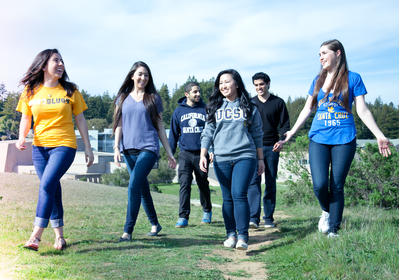UC Santa Cruz is poised to have about 3,500 new first-year students arriving in September, marking the 50th class of students who've chosen the campus for its commitment to undergraduate teaching and the opportunity for research.
With the largest applicant pool in the history of the campus, and a smaller freshman class than the previous year, the campus increased its admission selectivity, with the average high school GPA increasing from 3.6 to 3.75 and the average SAT total score rising from 1680 to 1750.
The vast majority of students - about 3,000 - will be from California, with the rest coming from other states or other countries.
"We continue to primarily educate California's students," said Michael K. McCawley, UCSC's director of admissions, "but today's student needs to prepare to succeed in a global society. To that end, having geographic diversity from within our state, from other states and other countries, enhances their educational experience."
UC Santa Cruz offered admission to 23,284 students for its fall 2015 freshmen class, according to data released today (July 2) by University of California's Office of the President. The largest portion - 17,588 or just over 75 percent - are students coming from California. Total freshman admission offers remained nearly the same, with 128 more students offered a seat than a year ago - a reflection of smaller enrollment targets for fall 2015.
The campus also offered admission to 4,342 students from a California Community College, an increase of 119 students (4.1 percent) from last year.
"Our increased efforts with students from California community colleges show positive results," said McCawley. "Ensuring that well-prepared transfer students can complete their studies and earn a UCSC degree within two years is a priority for our campus and the UC system as a whole."
Faculty and staff are in the midst of preparing to welcome the new class into the campus's distinctive residential colleges, first-year Honors Program, Challenge Program, and into ever-expanding opportunities for undergraduate research, internships, and creative projects with world-class faculty.
Despite record applications - nearly 55,000 students - the campus must enroll roughly 500 to 700 fewer students than a year ago, due to a large incoming class in fall 2014.
A smaller incoming freshman class will also mean fewer students from underrepresented groups than enrolled a year ago. The number of African American students admitted declined year-over-year by 180, from 700 to 520. Additionally, the number of Chicano/Latino students declined by 793, from 5,235 to 4,442.
"We've seen strong growth in the numbers of African American and Chicano/Latino students admitted in the last several years," McCawley said. "We want to make sure this decrease is an anomaly. We are going to work even harder to engage our students, alumni and faculty to make sure they're helping recruit and enroll students from underrepresented ethnicities."
Out-of-state and international students bring a diversity of perspectives to classrooms discussions and to the social and cultural atmosphere on campus. The campus offered admission to 2,500 out-of-state students and 3,196 international students.
"While the admission rate of out-of-state and international students is high, the number of these students that accept an offer of admission and eventually enroll is much lower than California students," McCawley explained.
The fall 2015 admitted class of California residents continues to be diverse with 34.6 percent Asian American, 32.2 percent white/other, 25.3 percent Hispanic/Latino, 3 percent African American, 0.9 percent American Indian, and 0.4 percent Pacific Islander. An additional 3.8 percent of admitted students did not report their race/ethnicity.



